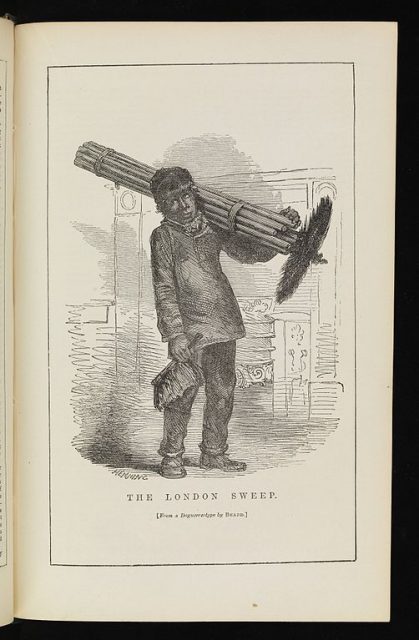In the latest from Anton Howes’ Age of Invention newsletter, we are introduced to the Society for the Encouragement of Arts, Manufactures and Commerce:

The London Sweep (from a Daguerreotype by BEARD).
Image from London labour and the London poor : a cyclopaedia of the condition and earnings of those that will work, those that cannot work, and those that will not work, 1851, via the Wellcome Collection.
When we think of the British Industrial Revolution, the image that springs to mind tends to be of soot-belching factories and foundries, of child labour and squalid cities. The inventors who spring to mind tend to be James Watt and his steam engines, or Richard Arkwright and his cotton-spinning machines. But what people tend to forget is that the Industrial Revolution was unleashed by a much broader tide of accelerating innovation — as I never tire of repeating, it touched everything from agriculture to watchmaking, and everything inbetween. Just as some inventors pioneered the use of factories, other inventors sought solutions to industrialisation’s social ills.
Last time, I mentioned the Society for the Encouragement of Arts, Manufactures and Commerce, set up in 1754 in a London coffee house (the Society of Arts for short). What’s so fascinating about the organisation — which still exists today, now called “Royal” — is that it was closely involved with many of the more socially-oriented innovations of the period. By this, I mean the kinds of inventions that were rarely immediately profitable, but which aimed to save lives, to alleviate suffering, or to remedy some other social ill. The Society advertised premiums — cash prizes or honorary medals — for solutions to the problems that its members identified. And it offered similar rewards, which they called bounties, for unsolicited inventions.
It awarded a bounty of fifty guineas and a gold medal to Henry Greathead, for example, one of the claimants for the invention of the lifeboat. It gave another fifty guineas to a sergeant of the Royal Artillery, John Bell, for a method of firing a rope and grapple by mortar from a ship to the shore, to save people on board from shipwreck during storms. (Some years later, it even gave a gold medal to another inventor for a device that did the opposite, firing from shore to ship.) The Society awarded a medal to a Sheffield schoolmaster, John Hessey Abraham, for a magnetic apparatus that would prevent metal dust getting into the eyes and lungs of workers employed in grinding the points of needles. And in 1767 it awarded a bounty to a clockmaker, Christopher Pinchbeck, for a safer crane — cranes at the time were like gigantic hamster wheels, but for humans. When lines snapped, the results could be fatal, so Pinchbeck added a pneumatic braking mechanism.
The list goes on — in all, over the course of about a century, the Society of Arts awarded over two thousand premiums and bounties for inventions. But there is one that really stands out: a premium for the invention of a mechanical means of cleaning chimneys. With such an invention, the Society hoped to abolish the employment of children, sometimes as young as 4, who were forced to climb up inside chimneys in order to clean them. These children were sometimes abducted by the master chimney sweeps, and frequently perished in horrific accidents or of soot-induced cancers. Strikingly, the use of climbing boys was thought to be unique to Britain — the “peculiar disgrace of England” as the campaigners put it (though I don’t think this was quite true). The Society’s idea was that if a technological replacement could be found, then the case for outright abolition could be made — they wanted to create a machine to take the children’s jobs.
The Society of Arts played its role with the offer of a premium, but it acted alongside another campaign run by a few of its members, who ran the snappily titled “Society for Superseding the Necessity of Climbing Boys, by Encouraging a New Method of Sweeping Chimnies, and for Improving the Condition of Children and Others Employed by Chimney Sweepers”, founded in 1803 at the London Coffee-House on Ludgate Hill. Let’s call it the SSNCB for short. There had been earlier campaigns to abolish the use of climbing boys, one of the most prominent being run by Jonas Hanway (a prominent philanthropist, also a member of the Society of Arts, whose various claims to fame include being the first man in London to sport an umbrella). But the 1803 campaign was to prove the most successful, drawing on wider political support. The SSNCB’s key members included William Wilberforce, who later became famous for his zeal in abolishing the slave trade.



